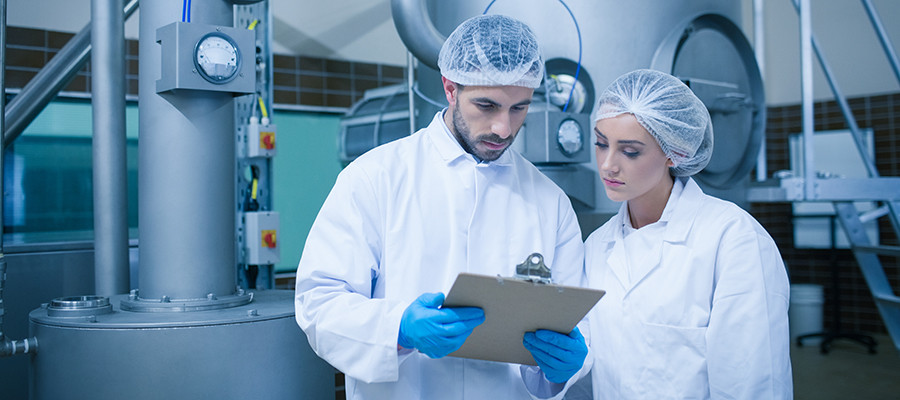Spray Technology for Food Processing

Consistency is important to nearly every area of life. In the food industry, it is crucial – especially when spray coatings are applied. On the front end, consistent coatings provide positive customer experience. At the factory, consistency provides cost and resource savings and an altogether more efficient process. The following content explores why coatings are so important, some examples of coated products, a brief review of the coating process, and the best spray nozzles to utilize to achieve consistency every time.
Why Is Coating Important?
Coating is the application of specific liquids or solids onto a food product. Dependent on mechanical energy, coating “consists mostly in setting the product particles in motion and simultaneously applying the coating ingredient in a certain pattern to expose one to the other.” Coating is utilized to achieve specific objectives. Chocolate might be coated to enhance taste and flavor. Vegetables are often coated and frozen for heightened taste and convenience. To increase palatability, snacks and crunchy nuts are coated. Cheese must be coated to prevent agglomeration. Cereals are often coating for enhanced flavor and appearance.
Various coating ingredients are applied in the process, in several fashions, each achieving a diverse result. Some common coating ingredients include water, alcohol, resin, wax, sugars, flours, seasonings (such as salt or flavor enhancers), oils, fats, and starches. For example:
- Alcohol, slightly diluted, is often used as a preservative for packaged pastries.
- Wax is commonly employed in a variety of forms for glazing, ultimately producing a pleasant aesthetic.
- Resin, which forms a film-like wax, is utilized similarly, often for glazing chocolates.
- Flours enhance thickness or crispiness. As in fresh cooking, flours often coat chicken nuggets before battering and frying.
- Oils are used in their purest form for a diverse range of purposes, from adhesion to anticaking. Interestingly, sometimes oils are included in ice cream.
- Water is commonly employed in its liquid or steam phases for dust prevention, freezer burn prevention, or enhanced adhesion.
What Does the Coating Process Look Like?
The coating process can be explained in three simple steps:
- Inputs: As the name implies, the base ingredient and any other additives are inputted into the spray coating system.
- Flows: The base product is coated with the desired ingredient.
- Outputs: The final product is produced.
What actually happens (scientifically) during those three simple steps is slightly more complex! Four processes take place: application, adhesion, coalescence, and stabilization.
Spray nozzles are utilized during the application process. Simply put, application is the process of spray coating the desired ingredient onto the base product. Adhesion occurs next, when the base ingredient and coating product adhere to each other. When liquid droplets form a single layer around the base ingredient, coalescence has been achieved. Finally, stabilization has occurred if the base ingredient has eliminated the solvents or crystalized. At the end of these four events, a base product is completely treated with a coating.
What Can Go Wrong?
Certain collaterals are bound to occur during the coating process. These are discussed below. However, with the right spray coating nozzle, each collateral can be dramatically reduced or entirely removed.
- Clogging: Clogging occurs when base ingredients and/or spray coating product get lodged in drains.
- Agglomeration: Though a natural process, agglomeration is far from desirable in the coating process. Agglomeration results in buildup or caking during powder coating.
- Product Damage: Fairly self-explanatory, product damage wastes money and resources.
- Inconsistency: We’ve all experienced inconsistency in spray coated foods. Recall a time when you ate an inconsistently spray coated bag of chips. Every other chip you pulled from the bag tasted like a raw potato. In between raw-potato slices, an explosion of salt bombarded your senses. This is a relatable example of spray-coated inconsistency –producing an incredibly poor user experience. What are the odds you switched potato chip brands? Perhaps you warned your friend before their next shopping experience to save them from your raw potato, sodium explosion fiasco.
Which Spray Nozzles Achieve Consistency – Every Time?
Inconsistency always provides unnecessary opportunity for your food company to accumulate a poor reputation, ultimately hurting your bottom line. Investing in the right nozzle for spray coating your food products is worth it. So, which nozzle is best? Which nozzles will achieve consistency every single time?
Depending on your specific application, certain variations of VarioSpray nozzle will best suit your company. VarioSpray systems are efficient, precise, and sustainable – extremely desirable characteristics for nearly every industry, especially food processing. These hydraulic pulse-width-modulated nozzle valve systems replace traditionally utilized structures, such as pneumatic atomizing systems or aerosols. VarioSpray systems are flexible and cost and resource-effective, formed from nozzles that achieve consistency every time.
- Flexible: VarioSpray nozzles are modular, easily adapted to the specific requirements of your specific application. Each valve is controlled by electronic components that match perfectly.
- Resource and Cost Savings: The aerosol-free atomization of minimal liquid volumes is hugely beneficial, because no atomization air is utilized. Rebound effects are reduced, resulting in minimal installation cleaning, fewer extraction system operating costs, less liquid losses, and maximum consistency.
- Minimal Amounts: The VarioSpray valves utilize pulse-width-modulation. This means that even the most minimal amounts of product are hydraulically, precisely atomized. The result: uniform spray quality and consistent coating.
Lechler: Your Spray Solution
In the nozzle technology industry for over 140 years, Lechler is dedicated to providing spray solutions that meet and exceed the expectations for your company. We work with food and beverage industries often – we understand your needs. We’ll provide individualized advice from members of our sales team to provide you with the perfect option for your company. Contact us today to discuss your custom spray coating solution!